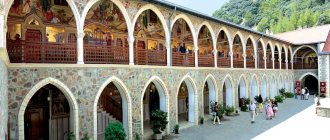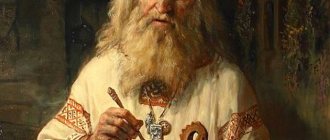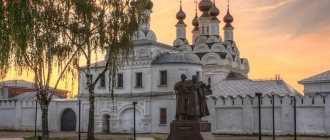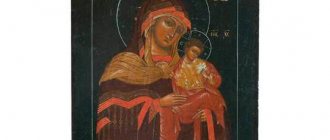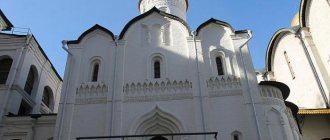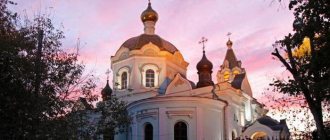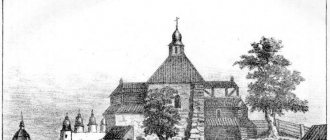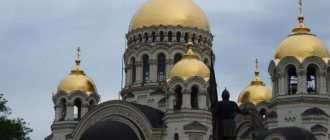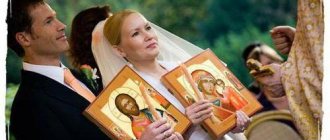| Kazan Church of the Vitebsk Markov Trinity Monastery |
Markov Monastery in the name of the Holy Trinity in Vitebsk,
Vitebsk diocese
- Address: Belarus, 210002, Vitebsk, st. Maxim Gorky, 84-a
- Tel.: (+375, 34-08-54
- On the map: Yandex.Map, Google map
Located in the southwestern part of Vitebsk, called, in honor of the monastery, Markovshchina.
Base
According to legend, the history of the monastery begins with the fact that a certain Mark, who owned a plot of land 4 versts from Vitebsk, built a small chapel on it and retired to it for pious deeds. Soon like-minded people began to join him and a monastery was formed, and then a monastery. It is most likely that this happened in the 14th or early centuries. After some time, most likely due to wars, the monastery disappeared. In the second half of the century, the monks revived the monastery here with the Church of St. John.
The first known written evidence of the monastery dates back to 1576, in a letter of grant from King Stefan Batory to “Archpriest Markov” Feofan Rpinsky. Perhaps such a mention indicates that the monastery was abolished and its church served as a parish church.
After the conclusion of the Union of Brest in 1596, the Orthodox Church in the Polish-Lithuanian Commonwealth was oppressed; it was forbidden to build Orthodox churches in Vitebsk, and the spiritual needs of the Orthodox had to be satisfied in temporary buildings in the vicinity of the city.
Stronghold of Orthodoxy during the Uniate period
In 1633, the Orthodox Prince Lev-Samuel Bogdanovich Oginsky, thiun of Trotsky, built a small wooden Trinity Church and cells for monks on his Markovo estate, on the site of the original chapel. In 1642, Lev Oginsky assigned the Markovo estate and the Shidlovshchina farm, purchased from Ivan Kisel Zagorensky and Martin Shidlovsky, to the monastery with a fundush charter.
In 1651, the wooden Intercession Church was built by the abbot of the monastery Kallist (Dorofeevich-Rytoraisky) [1]. According to the church hierarchy, the monastery was then subordinate to the metropolitans of Kyiv.
With the outbreak of the new Russian-Polish War in 1654, Vitebsk and Polotsk, for some time, passed to the Moscow state, and the monastery, like the entire Polotsk diocese, was subordinated to the Moscow Patriarchate. In 1656 [2], Patriarch Nikon of Moscow and All Rus' donated to the monastery, on behalf of Tsar Alexei Mikhailovich, a copy of the Kazan Icon of the Mother of God, which became the main shrine of the monastery.
At the end of the 1680s, the monastery was badly damaged by fire: both of its churches burned down. In 1690, Prince Simeon Karl Oginsky, son of Lev Oginsky, according to his father’s will, restored the monastery. First, the wooden cathedral church of the Holy Trinity was rebuilt - surrounded by an open gallery with carved wooden columns, the Trinity Church was a magnificent example of Belarusian wooden architecture. A temple was also erected on the site of the burnt Church of the Intercession.
In the 18th century, the monastery continued to be attacked by Roman Catholics - so, in 1751, Uniate missionaries and gentry attacked the monastery, during which the monks were dispersed, valuable items, documents and privileges were stolen. Despite this, the monastery successfully defended itself and construction continued. In 1730, in the monastery farm of Shidlovshchina, a mile from the monastery, a wooden church of St. Paraskeva was built, also with a gallery around it. In 1760, Abbot Iakinf (Pelkinsky), to replace the lost one, erected a new Church of the Intercession, now made of stone. Behind the monastery fence, on Nemtseva Hill, in the cemetery, in 1780 a wooden St. Nicholas Church was built. On the very bank of the Western Dvina there was also a chapel in the name of St. Nicholas. Also built in the monastery were: a stone three-tier bell tower, abbot's and brethren's buildings, and outbuildings.
Russian period
In 1772, Vitebsk became part of Russia. In 1773, by decree of the Holy Synod, the Markov Monastery was assigned to the Pskov diocese, and in 1795 - to the Mogilev diocese, and in 1798 it was elevated to the degree of archimandry.
In 1812, the monastery was again destroyed, this time by Napoleon's troops. Most of the valuable property was taken away by the invaders, but the monks managed to hide the revered Kazan Icon of the Mother of God in the forest. After World War II, the monastery was restored through the efforts of donors.
In 1833, the monastery became part of the newly opened Polotsk diocese.
In the 19th century, a number of reconstructions of churches were carried out - the Paraskevi Church was rebuilt in 1810 and 1842, the St. Nicholas Church in the cemetery - in 1856. In 1847, the Mitrofanovsky chapel was added to it from the west of the Intercession Church.
In 1900, the monastery was a first-class monastery with 4 churches. At the beginning of the century, the monastery was brought into excellent condition by its rector, Archimandrite Panteleimon (Rozhnovsky), the future Metropolitan of Minsk.
Soviet period
With the establishment of Bolshevik power, the monastery began to be subjected to devastation and destruction. The monastery was closed, and in 1919 its buildings were given to the Vitebsk Cheka for the organization of a concentration camp. In 1922, an orphanage was organized on the premises of the monastery for 250 children who arrived in Vitebsk from the starving Volga region. The following year, the orphanage was closed, and the Markovshchinsky Youth Union was located in the monastery, and a little later - the 4th police department of the city.
During the Second World War, during the German occupation, a parish was opened at the monastery Church of the Intercession. At the same time, this temple was re-consecrated in honor of the Kazan Icon of the Mother of God. During the war, the church was partially destroyed.
After the war, in 1945, the territory of the former monastery was given over to a rubber-band factory under construction (later a silk weaving plant). By this time, only the Kazan Church, a residential building and a bell tower remained from the monastery buildings. The last one was demolished in the late 1970s.
Restoration of the monastery
On November 23, 2000, the monastery was restored by decision of the Synod of the Belarusian Orthodox Church on the basis of the Kazan parish. Since the early 2000s, the Church of the Kazan Icon of the Mother of God was restored, a library, a Sunday school, a refectory for the poor and a shelter for the homeless were opened at the monastery. The revered Kazan Icon of the Mother of God in a silver frame was returned to the monastery and began to be brought to religious processions on the days of great holidays.
Story
According to legend, the history of the monastery begins with the fact that a certain Mark Zemyanin, who owned a plot of land 4 miles from the city, built a small chapel on it. Mark began to live with her, and soon like-minded people began to join him. This is how a monastery was formed, and then a monastery. It is not known for certain when these events occurred. Most likely in the 14th or 15th centuries. According to legend, the monastery fell into disrepair over time.
In the 17th century, the Orthodox Church was oppressed by the Uniates. In Vitebsk itself it was forbidden to build Orthodox churches. Orthodox believers had to satisfy their spiritual needs in a hut in the outskirts of the city.[1] In 1633, Prince Lev-Samuel Bogdanovich Oginsky, thiun of Trotsky (Troksky), with his wife Sophia, being Orthodox, founded the new Markov (Markovsky) monastery: they built a wooden Trinity Church
and cells for monks.
And in 1638 (1642?) Lev Oginsky assigned to the monastery the estates of Markovo
and
Szydlovshchina
, purchased from Jan Kisel Zagoransky and Martin Szydlovsky.
In 1651, the wooden Intercession Church
[2]. According to the church hierarchy, the monastery was then subordinate to the metropolitans of Kyiv, and they, in turn, were subordinate to the Patriarch of Constantinople.
With the beginning of the Russian-Polish War of 1654-1667, Vitebsk and Polotsk, for some time, passed to the Moscow state. Moscow Tsar Alexei Mikhailovich restores the ancient Orthodox Polotsk diocese and subordinates it to the Moscow Patriarchate. Markov Monastery also comes under the authority of Moscow Patriarch Nikon.
In 1657, Patriarch Nikon gave the monastery its main shrine to this day - a copy of the Kazan Icon of the Mother of God. The icon was presented on behalf of Tsar Alexei Mikhailovich.
Active construction period
View of the monastery, before 1865
At the end of the 1680s, the monastery was badly damaged by fire: both of its churches burned down. In 1690, Prince Simeon-Karl Oginsky, son of Lev Oginsky, a Catholic, according to his father’s will, restored the monastery. First, the wooden cathedral church of St. Trinity. The church was surrounded by an open gallery with carved wooden columns. Trinity Church, according to many, was a magnificent example of Belarusian wooden architecture.
In 1730, in the monastery farm of Shidlovshchina, a mile from the monastery, a wooden church of St. was built, also with a gallery around it. Paraskeva. The church was rebuilt in 1810 and 1842[3].
The only church of the monastery that has survived to this day was built in 1760 by Abbot Iakinf of Pelkinsky. This is the stone Church of the Intercession
(now reconsecrated to Kazan).
Behind the monastery fence, on Nemtsevaya Hill, in the cemetery, a wooden St. Nicholas Church was built in 1730 (rebuilt in 1856).
On the very bank of the Western Dvina, there was also a chapel in honor of St. Nicholas. People called it affectionately - by the name of Mikolushka.[2]
Also built in the monastery were: a stone two-tier (the third tier was built in the 19th century) bell tower, abbot's and brethren's buildings, and outbuildings.
In 1751, the abbot of the monastery Serapion Pchelka, having himself converted to the union, tried to transfer the monastery to the union, but this was prevented by the fundush letter of Prince Lev Oginsky, according to which the monastery should always remain Orthodox, as well as the efforts of the next abbot Iakinf Pelkinsky [4]. According to another version, the Vitebsk Uniate dean Casimir and the gentry burst into the monastery, seized abbot Seraphim Kochet, dispersed the monks, and the monastery for some time went into the union[5]. When trying to bring the monastery into the union, the monastery was looted, valuable items, documents and privileges were stolen. [6]
Russian period
Until 1893
In 1772, Vitebsk goes to Russia, and the monastery comes under the jurisdiction of the Moscow Patriarchate. In 1773, by decree of the Holy Synod, the Markov Monastery was assigned to the Pskov diocese. Then, in 1795 - to Mogilev, and in 1798 he was elevated to the degree of archimandry.
In 1812, the monastery was again destroyed. This time, by Napoleon's French troops. Most of the valuable property was taken away by the invaders, but the monks managed to hide the Kazan Icon of the Mother of God in the forest. After World War II, the monastery was restored through the efforts of donors.
In 1833, the monastery was placed under the jurisdiction of the newly opened Polotsk diocese.
In 1900, the monastery was a first-class monastery with 4 churches.
At the beginning of the 20th century, the monastery was brought into excellent condition by its abbot, Archimandrite Panteleimon (in the world - Pavel Rozhnovsky) - the future Metropolitan of Minsk and all Belarus, and during the German occupation - the head of the Belarusian Orthodox Church. The monastery complex was surrounded by a stone fence and consisted of the Holy Trinity, Holy Protection, St. Nicholas, St. Paraskevskaya churches, a bell tower, the hegumen's house, a fraternal house and outbuildings[7].
Soviet period
With the onset of Soviet power, the monastery began to be subject to devastation and destruction. In 1918[7] the monastery was closed. In 1919, the buildings of the former monastery were given to the Vitebsk Cheka for the organization of a concentration camp (1920-1921)[8]. In 1922, an orphanage was organized on the premises of the monastery for 250 children who arrived in Vitebsk from the starving Volga region. The following year, the orphanage was closed, and the Markovshchinsky Youth Union was located in the monastery, and a little later - the 4th police department of the city.
During the German occupation, the parish of the Intercession Church was opened. At the same time, this church was reconsecrated into the Temple of the Kazan Icon of the Mother of God.
After the war, in 1945, the territory of the former monastery was given over to a rubber-band factory under construction (later a silk weaving plant). By this time, all that remained of the monastery buildings was the Intercession (Kazan) Church, residential and utility buildings, and the bell tower (it was demolished in the late 1970s).[9]
Restoration of the monastery
On November 23, 2000, the monastery was restored by the decision of the Holy Synod of the Belarusian Orthodox Church. In recent years, the Church of the Kazan Icon of the Mother of God has been restored.
The monastery operates a library and a Sunday school, a refectory for the poor, and a shelter for the homeless.
Temples
Kazan Temple
- Thrones: Kazan Icon of the Mother of God (main), St. Sergius of Radonezh (side chapel)
The temple is stone, cross-domed. The 6-sided drum of the dome is supported on 4 pillars. The main rectangular volume has three semi-cylindrical apses, the central one protruding significantly forward. Adjacent to the main volume is a developed vestibule-babinets. The interior is divided into 3 naves by two walls with arched openings. In the central apse, an old arched window has been preserved, blocked with bricks, decorated with a Baroque casing in the form of an applied portico with an intricately shaped pediment. The remaining openings are decorated with semicircular archivolts. The facades are decorated with profiled rods, cornices, corner pilasters and crosses. The facades end with triangular pediments.
On the eastern side of the temple there is a monastery cemetery.
Gallery
- Trinity Church, before 1865
- View of the monastery, 19th century
- Markov Mon. D. Strukov, 1864
- Trinity Church. Hood. I. P. Trutnev. 1866
- Trinity Church, bell tower. 1864-67 Hood. D. M. Strukov
- Plan of the monastery from 1901.
- Trinity Church, early 20th century
- Monastery courtyard and bell tower, early 20th century
- Trinity Church, 20th century(?)
- Church of St. Paraskeva Pyatnitsa, con. XIX - early XX centuries.
- Nicholas Church of the Markov Monastery.
- Kazan Church, view from the north side.
- Nicholas Church and Nemtseva Gora.
- On the way from St. Nicholas Church to the stone monastery fence.
- Summer Cathedral in honor of the Holy Trinity.
- Monastic settlement (Markovshchina), early 20th century
- Pier at the Markov Monastery.
- Pier at the Markov Monastery.
- Kindergarten of the Dvina factory on the territory of the Kazan Church. 1932
- View of the Markov region during the German occupation
- Abbot's building, 1950s
- Kazan Church. 1950s
- Markov Monastery Exit to Maxim Gorky Street 1950s
- Gate from the side of Maxim Gorky Street. 1950s
- Markov Monastery. 1950s
- Kazan Church, July 2011
- Monastery building. The first floor of the building is apparently pre-revolutionary.
- Entrance to the monastery territory
- Monastery territory
- Markov Monastery behind the buildings of the silk fabric factory. June 2017
Abbots
- Feofan (Rpinsky) (? - 1576)
- Kallist (Dorofeevich-Rytoraisky) (mentioned 1651 - mentioned 1656)
- Nectarius (mentioned 1669) [3]
- Leontius (mentioned 1679) [4]
- Feofan (Ivanovich) (mentioned 1687; 1695) [5]
- Serapion (Polkhovsky) [5]
- Sylvester (Konarsky) (mentioned 1713) [5]
- Meletius (Tchaikovsky) (until 1715) [6]
- Methodius (Oleshkevich) (mentioned 1718) [5]
- Seraphim (Kochep) (before 1751) [6]
- Iakinf (Pelkinsky) (1752 - 1766) [5]
- John (Lukianovich) (mentioned 1766) [5]
- Sylvester (Golinkovich) (mentioned 1768) [5]
- Sozont (1776 - 1780) [5]
- Peter (1780 - 1785) [5]
- Dosifey (Bykovsky) [5]
- Anatoly (1818 - 1822) [5]
- Jerome (Sretensky) (1822 - 1832) [5]
- Pavel (Chichkevich) (1832 - 1861) [6]
- Anatoly (Stankevich) (April 4, 1861 - 1867)
- Polievkt (Pyaskovsky) (1867 - 1873)
- Arkady (Filonov) (January 16, 1873 - 1885)
- Ioannikiy (Kazansky) (1885 - 1888)
- Hilarion (1888 - 1894) [7]
- Vitaly (ment. 1895) [7]
- Ignatius (mentioned 1904) [7]
- Panteleimon (Rozhnovsky) (1905 - 1912)
- Gerontius (mentioned 1913) [7]
- Porfiry (mentioned 1914) [7]
- Tavrion (Batozsky) (1925 - 1926)
Notes
- Macarius (Bulgakov) Metropolitan of Moscow and Kolomna. History of the Russian Church. M.: Publishing house of the Spaso-Preobrazhensky Valaam Monastery. 1994-1996. Volume 6
- ↑ 12
Brochure “Holy Trinity Markov Monastery”, publication of the monastery - Statistical information about churches and clergy of the Polotsk diocese. Vitebsk. 1884
- Description of the Markov Monastery, Hieromonk Sergius. Memorial book of the Vitebsk province for 1865. — St. Petersburg: 1865
- Bez-Kornilovich M. O. Historical information about the most remarkable places in Belarus with the addition of other information related to it. - St. Petersburg, 1855.
- Teplova V. A. Orthodox historical and cultural school of Belarus at the end of the 18th century - beginning. XX centuries: genesis and traditions
- ↑ 1 2 Kulagin A. M.
Orthodox churches in Belarus: Encyclopedic data. - Mn.: BelEn, 2001. - 328 p. — ISBN 985-11-0190-7 - Already in September 1919, a concentration camp was created on the territory of the Markov Monastery, the number of prisoners of which could include ticketless travel on transport, moonshine, speculation, desertion, prostitution, counter-revolutionary agitation, espionage, hostility towards Soviet power. The term of imprisonment was set from several months until “the date of the end of the Civil War, if any.” Abramova I. Camp in the monastery
- https://vitebskbiker.info/guide/settlements/vitebsk/markovschina
MARKOV VITEBSKY IN THE NAME OF THE HOLY TRINITY MONASTERY
Markov Holy Trinity Monastery. Watercolor. 1864 Artist. D. Strukov (B-Vilnius State University)
Markov Holy Trinity Monastery. Watercolor. 1864 Artist. D. Strukov (B-Vilnius State University)
(Vitebsk and Orsha Diocese of the Belarusian Exarchate of the Russian Orthodox Church), located in Vitebsk (Belarus). Created in 1633 on the basis of the Polish privilege. cor. Vladislav IV Vasa and with the blessing of the Kyiv and Galician Metropolitans. Petra (Grave) Orthodox. gentry prince Samuel Lev Oginsky and Bratslav zemstvo judge Sevastyan Mirsky. The monastery was built on the territory of Oginsky’s private estate, located on the right bank of the river. Zap. Dvina, opposite the city of Vitebsk (AZR. T. 5. No. 164. P. 194). The monastery's possessions included c. in the name of the Holy Trinity, originally located southwest of Vitebsk, on the right bank of the river. Zap. Dvina, in places. Markovshchina. Traditionally, in church historiography it is believed that until 1576 there was a Trinity Monastery here, founded by the monk Mark. However, this is not confirmed by sources. Mark was probably the owner of the Markovshchina estate and the 1st ktitor of the Trinity Church. One can identify Mark with the Gospodar boyar of the Vitebsk povet Mark, whose widow Natomila and her sons Mikhno, Yukhno and Bogdan sued the priest in 1546. Feodor Kolosha, a cleric of the Ioanno-Theological Church, for the right to own the church land “Fedorovschina”, considering it a “service” of her husband (Vitebsk Antiquity. 1883. T. 1. No. 23. P. 43-46).
15 Dec. 1576 Trinity Church was first mentioned as a parish church, and its rector was characterized as “a thoughtful man, skilled in all spiritual matters and scientific in writing.” In the same year, the Trinity archpriest Theophan (Bogdan Rpinsky; † Aug. 1588), who came from a family of Ashmyany zemyans, was consecrated by the Kyiv and Galician Metropolitans. Metropolitan Jonah III to the Polotsk, Vitebsk and Mstislav archbishopric departments of the Western Russian Metropolis (Ibid. 1888. Vol. 5. Part 1. No. 44. P. 56-60).
In M. m., a church was built at the expense of Oginsky and Mirsky. in honor of the Intercession of the Holy. Mother of God and cells. The need for a monastery for the local Orthodox Church. population was huge, because after the Vitebsk uprising of 1623 and the murder of the Uniate archbishop. Josaphat Kuntsevich by order of the Polish. cor. Sigismund III Vasa closed all Orthodox churches in the city. True, 7 Oct. In 1633, all benefits were returned to the residents of Vitebsk after the successful Smolensk military campaign under Polish charters. cor. Vladislav IV Vasa, who, however, confirmed in them the rights of the Uniates to the Polotsk diocese, emphasizing that “in Vitebsk, Polotsk and Novogorod, non-Uniates will never have any church.” This decision of the king was confirmed on March 14, 1635 (Ibid. 1883. T. 1. No. 57/58. P. 114-115; No. 66. II. P. 127-129).
In 1638, M. M. received from the ktitors 2 estates - Markovshchina and the Shidlovshchina farm. Metropolitan Peter (Mogila), at the request of the ktitors, sent an abbot and monks to the M. m. According to the written order of Prince. Oginsky, M. M. should always remain Orthodox. If his abbot becomes a Uniate and supports the Union of Brest of 1596, then he should be overthrown from the M. m. This order was very relevant, because back on May 1, 1636 cor. Vladislav IV Vasa sent his decree to the Polotsk, Vitebsk and Mstislav archbishops. Sylvester (Kosov), former Zemyanin of Vitebsk Povet. The ruler of the Polish-Lithuanian Commonwealth forbade him to come to Polotsk and Vitebsk, where the bishop was supposed to perform Orthodox services. divine services and other holy duties (Ibid. No. 61, pp. 118-119).
Cathedral Church in the name of the Holy Trinity (1690–1691). Watercolor. 1866 Artist. I. P. Trutnev (Vilnius State University Library)
Cathedral Church in the name of the Holy Trinity (1690–1691). Watercolor. 1866 Artist. I. P. Trutnev (Vilnius State University Library)
However, Archbishop. Sylvester violated the royal order: he visited Vitebsk, where on May 13-23, 1636 he lived “in an apartment on the parade ground of the Braslav judge Ivan Mirskago,” a relative of S. Mirsky. In the city he performed divine services and, undoubtedly, visited M. m. Thanks to his actions, many. the residents of Vitebsk returned to Orthodoxy, which caused a protest from the Uniate. Bishop Anthony (Selyava), who demanded that the king arrange a speedy investigation into what had happened (Ibid. No. 62-63. P. 120-123; 1888. T. 5. Part 1. No. 98. P. 149). Despite a fine of 10 thousand zlotys, the archbishop. Sylvester (Kosov) continued his pastoral work in Vitebsk, relying on the authorities of the M. m. So, on May 31, 1641, the bishop received a summons from the Orsha subordinate Yakov Visloukha. It reported on the decision of the Vilna Tribunal of July 31, 1640 on the complaint of the Uniate Archbishop. Antonia (Selyava) against Yuri Tsypka and his wife, accused of “violating the peace between Uniates and non-Uniates, various disturbances, construction in the city of Vitebsk beyond the river. Dvina, in Slobodsky Posad, the Orthodox Church, the indignation of the common people and their joining to Orthodoxy,” as well as about “the forcible taking away of church soils by the monk Elisha and the removal of rye from them.” Mon. Elisha was probably a monk of M. m., since other orthodox. there were no monasteries near Vitebsk (Ibid. 1888. T. 5. Part 1. No. XXII. P. 156).
Despite the persecution, the activities of the Orthodox Church. clergy, including the brethren M. m., led to the fact that on March 21, 1646, Archbishop. Anthony (Selyava) stated that most of the townspeople returned from the union to Orthodoxy (Ibid. Vol. 1. No. 68. pp. 134-137).
In 1650, a wooden center was built in M. m. in the name of the Holy Trinity. During the Russian-Polish war (1654-1667), the monastery received a copy of the Kazan Icon of the Mother of God as a gift (see Vitebsk Markov Monastery Icon of the Mother of God). According to some sources, this image was granted to the Moscow Museum in 1655 by Tsar Alexei Mikhailovich, when the population of Vitebsk Mikhail. but voluntarily submitted to his authority; according to others, with this list of the miraculous icon Nikon, the Patriarch of Moscow and All Rus' blessed the “Life-Giving Trinity, Markov and Vitepsk Monasteries” by the abbot. Callista (Dorofeevich-Ritoraisky), “a pious and God-fearing husband, and skilled in good things,” appointed on March 13, 1656 as governor of the Polotsk See (DRV. Part 3. No. 6. pp. 300-306). It is possible that the icon was donated to M. back in 1651.
Church of St. Nicholas the Wonderworker. 1730 Photograph. Beginning XX century
Church of St. Nicholas the Wonderworker. 1730 Photograph. Beginning XX century
In 1675, the rights and privileges of the M. m. brethren were confirmed by the bishop. Mstislavsky, Orsha and Mogilev Feodosius (Vasilevich). On July 8, 1686, the vicar and administrator of the Belarusian diocese, Sylvester Volchansky, issued a blessed and confirmatory letter to the authorities of the Polotsk Epiphany Brotherly Monastery and M. M. granting them the ancient rights, confirmed by previous archbishop's letters, to send their monks one by one to the city of Riga, so that in her Orthodoxy. in churches to perform divine services, perform services and collect alms (AZR. T. 5. No. 164. P. 194-195). 17 Feb. In 1687, this decision was confirmed by the Kyiv Metropolitan. Gideon (Svyatopolk-Chetvertinsky), who demanded that the authorities of the Disnensky and Druysky monasteries respect the rights of M. m. (Ibid. No. 170. P. 209-210). However, apparently, the services in Riga never took place, and in 1696/97 the abbot of the Polotsk Epiphany Brotherly Monastery, abbot, was forced to contact Adrian, Patriarch of Moscow and All Rus', on this issue. Callistus and abbot M. M. Feofan “with the brethren.” 2 Feb In 1697, the patriarch issued them a new charter, confirming the exclusive rights of both monasteries to liturgical activities in Riga (Ibid. No. 270, pp. 280-281), and in 1699, their authorities, presenting the privileges of the Kyiv Metropolitan. Varlaam (Yasinsky), obtained a new letter of confirmation on this issue from both the Mstislav and Mogilev bishops. Serapion (Polkhovsky) (Ibid. pp. 287-288).
In 1690, wooden Trinity and Intercession churches were built on the site of the Moscow metropolitan area that burned down. The patron of the first of them was the swordsman of the Grand Duchy of Lithuania, Prince. Simeon Karl Oginsky. In the 18th century in Vitebsk the monastery owned several courtyards, and outside the city - several. villages 28 Nov 1720 M. M., among other Orthodox monasteries, received confirmation of its rights and freedom of religion within the Grand Duchy of Lithuania from the Polish. Cor., Saxon hertz. and Litovsky led. book Augustus II the Strong (ArchYuzR. Part 1. Vol. 4. No. 182. P. 404). In 1751, the Uniates attempted to seize power in the Monastery. However, it failed, since the court took into account the Orthodox instructions to the letter of the late ktitor of the monastery, Prince. S. L. Oginsky.
In 1730, under the abbot of Abbot. Methodius (Oleshkevich), a wooden church was built behind the fence. in the name of St. Nicholas the Wonderworker (rebuilt and consecrated on June 3, 1856 by Vasily (Luzhinsky), Archbishop of Polotsk and Vitebsk), and on the monastery farm of Shidlovshchina there is a wooden church on a stone foundation. in the name of the military center Paraskeva. Nearby there was a healing spring in the name of the Military Medical Center. Paraskeva and the chapel. In 1760 (1752?) in M. m. on the site of the Pokrovskaya church. A stone temple was built in the Baroque style with elements of early classicism. It was cross-domed, had a developed porch, 3 semicircular apses, high arched windows and pilasters. A decorative frame-hood was placed on the central apse. The side facades of the temple and its vestibule ended with triangular pediments with arched openings. In 1750-1760 a bell tower was erected, the 3rd tier of which was completed in 1858, under the rector, Archimandrite. Pavle (Chichkevich). There were 8 bells on the bell tower, the largest weighed 130 pounds.
In 1773, by decree of the Synod, M. m. was assigned to the Pskov diocese, January 10. 1795 reassigned to the Mogilev diocese. Since 1798, the rectors have been archimandrites. In 1812, M. m. was plundered by French troops. imp. Napoleon I, but the monks managed to hide the Kazan Icon of the Mother of God in the forest. Soon the M. m. was revived, and in 1833 it was reassigned to the Polotsk diocese. In 1839, after the transfer of the episcopal see from Polotsk to Vitebsk, the Bishop of Polotsk settled in M. m. Isidore (Nikolsky). In the monastery, an addition was made to the Church of the Intercession on November 2. 1847 Archbishop. Polotsky Vasily (Luzhinsky) consecrated the church. in the name of St. Mitrofan of Voronezh.
VMC Church Paraskeva. 1730 Photograph. Beginning XX century
VMC Church Paraskeva. 1730 Photograph. Beginning XX century
In 1842, M. m. was elevated to the level of 1st class, its content was approved by the Highest and amounted to 3185 rubles. silver per year (by 1912 the content increased to 4085 rubles). 160 dessiatines were left for the use of the monastery. arable and hay land, 140 des. wood forest. Part of this land (the Shidlovshchina farm) was cultivated by the inhabitants themselves; the Yurkovshchina farm was rented out for 100 rubles. Mont-Rue belonged to the lake. Komanskoye (Koshanskoye), rented out for 152 rubles, the mill was rented out for 600 rubles. By Jan. In 1854, the staff of M. M. assumed 20 residents, but only 10 people lived in it. The provincial Nevelsky Monastery was assigned to the monastery, to which funds were allocated for 3 hieromonks, a hierodeacon and a novice. In 1884, a school was established at M. m. In 1912, at the request of Bishop. Polotsk and Vitebsk Nikodim (Bokov) by the decision of the Synod of M. was converted into a dormitory. In 1913, its rector (since 1905) Archimandrite. Panteleimon (Rozhnovsky) was consecrated Bishop of Dvina, vicar of the Polotsk diocese.
Church in honor of the Kazan Icon of the Mother of God. 1752–1763 Photo. 2015
Church in honor of the Kazan Icon of the Mother of God. 1752–1763 Photo. 2015
In 1920, the M. m. was closed; in 1922, an orphanage was organized in its buildings. Mn. buildings were destroyed, including the Trinity Church - a Belarusian monument. wooden architecture. During the Great Patriotic War of 1941-1945. In the Intercession Church, reconsecrated in honor of the Kazan Icon of the Mother of God, services resumed. During the days of Bright Week 1942, Vitebsk was visited on a missionary trip by the resident of the Zhirovitsky monastery in honor of the Dormition of the Most Holy Theotokos, Archimandrite. sschmch. Seraphim (Shakhmut) together with priest. Grigory Kudarenko (later Archimandrite Ignatius). The Kazan Church suffered during the liberation of Vitebsk from the Nazi occupiers, then it was repaired. This church remained the only one in Vitebsk that did not close after the war. The main altar of the temple was consecrated in honor of the Kazan Icon of the Mother of God, the chapel - in the name of St. Sergius of Radonezh. Dr. The monastery buildings were transferred to a rubber band factory, then to a silk fabric factory. In con. 70s XX century The monastery bell tower was demolished.
23 Nov In 2000, by decision of the Synod of the Belarusian Orthodox Church, the monastery was revived. In the summer of 2002, the silk fabric factory handed over a 5-story administrative building to the monastery. The Kazan Church was restored, and a copy of the Kazan Icon of the Mother of God (17th century) in a silver frame was transferred to it. Among the shrines of the monastery are arks with particles of the relics of Saints Gregory the Theologian, Pitirim, Archbishop. Tambovsky, Joasaph (Gorlenko), bishop. Belgorodsky, Filaret (Drozdov), Metropolitan. Moskovsky, sschmch. Vladimir (Bogoyavlensky), Metropolitan. Kievsky, as well as St. Venerables of Diveyevo Elena, Martha and Alexandra and an icon with a particle of the relics of the great martyr. Panteleimon. Residential and utility buildings have been restored. The rector of the M. m. is the archbishop. Vitebsk and Orsha Dimitri (Drozdov), viceroy - priest. Aristarchus (Misnik).
Source: DRV. 17882. Part 3. No. 6. P. 300-306; AZR. T. 5. No. 164. P. 194-195; No. 170. P. 210; No. 270. pp. 280-281; No. 278. pp. 287-288; ODDS. T. 2. Part 1. Stb. 372; Adj. No. 30-31. Stb. CCIV-CCVIII; T. 3. Stb. 136. Adj. No. 26, 29. Stb. LXXXIV-XCII, CXIII; Vitebsk antiquity. Vitebsk, 1883. T. 1; 1888. T. 5. Part 1; ArchYuzR. Part 1. T. 4. No. 182. P. 404.
Lit.: IRI. Part 5. P. 48; Govorsky K. East. information about the monasteries of the Polotsk diocese. Polotsk, 1854; Bez-Kornilovich M. O. East. information about the most remarkable places in Belarus with the addition of other information related to it. St. Petersburg, 1855. Minsk, 1995. P. 51; Memorial book of the Vitebsk province. for 1865 Vitebsk, 1865; Sergius (Vasilevsky), priest. Vitebsk Markov Holy Trinity husband. mon-ry, with a view. Vitebsk, 1887; Sapunov A.P. Ancient icons of the Mother of God in the Polotsk diocese. Vitebsk, 1888; Zverinsky. T. 1. No. 290. Stb. 179-180; Pavlinov A. M. Ancient temples of Vitebsk and Polotsk. M., 1895; Dovgyallo D.I. Markovsky Haidamaks: Ist. essay from the history of the Vitebsk Markov Monastery of the 17th century. Vitebsk, 1896; Holy Trinity Markov Monastery in Vitebsk. St. Petersburg, 1911; Villager E. Mother of God. 2002. Book. 2. P. 76; Temples and parishes of the Vitebsk diocese of the Belarusian Orthodox Church. Churches. Vitebsk, 2002; Architecture of Belarus: Narys evalutsyi va ўkhodnon-Slavic i ўrapeyskim kantekstse. Minsk, 2006. T. 2: XV - syar. XVIII century
A. V. Kuzmin
